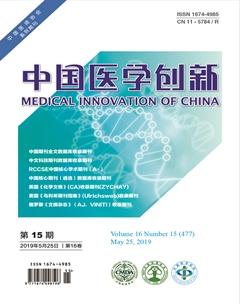首发精神分裂症患者归因方式与精神症状的关系
李庆伟 曾海萍 黄彩英


【摘要】 目的:探討首发精神分裂症患者归因方式的特点及其急性期与精神症状的关系。方法:采用阳性与阴性症状量表(PANSS)及内在、他人、环境归因问卷(IPSAQ)对50例首发精神分裂症患者(病例组)在入院时、第4周及第8周进行精神症状与归因方式的重复测评,并分析入院时(急性期)归因方式与精神症状的相关性及其与49例健康对照(对照组)归因方式的差异。结果:Mann-Whitney U检验显示病例组急性期负性事件外部他人归因分数显著高于对照组(U=827.00,P<0.05)。Spearman相关分析显示阳性症状评分与负性事件内归因分数呈正相关(r=0.336,P<0.05),与负性事件外部他人归因呈负相关(r=-0.379,P<0.01);PANSS总分与负性事件内归因分数呈正相关(r=0.297,P<0.05),与EB呈负相关(r=-0.297,P<0.05)。Friedman检验显示归因维度负性外部他人归因分数、EB随着治疗时间上升,差异均有统计学意义(字2=7.195、9.556,P<0.05)。结论:精神分裂症患者较健康人群有更高的负性事件外部他人归因倾向,精神症状越严重,其“自我责备”的倾向越明显,提示患者的归因方式具有一定的特质性及状态性。
【关键词】 首发; 精神分裂症; 归因; 精神症状
【Abstract】 Objective:To explore the attribution characteristics of first episode schizophrenia patients at different stages and the relationship between attribution style and psychiatric symptoms.Method:The first episode schizophrenia patients(n=50)were assessed repeatedly with the positive negative symptoms scale(PANSS)and the internal personal and situational attributions questionnaire(IPSAQ)at admission,the fourth and eighth week of treatment respectively.The relationship between attribution style and psychiatric symptoms and the difference between attribution style and normal control group(n=49)were analyzed using the baseline scores at admission.Result:Mann-Whitney U test indicates that at admission with active symptoms,the external attribution score of negative events in the patients group was significantly higher than that in the control group(U=827.00,P<0.05).Spearman correlation analysis showed that positive symptom score was positively correlated with internal attribution score of negative events(r=0.336,P<0.05),negatively correlated with personal attribution score of negative event(r=-0.379,P<0.01).Total PANSS score was positively correlated with internal attribution score of negative event(r=0.297,P<0.05),negatively correlated with external bias(EB)(r=-0.297,P<0.05).Friedman test showed that personal attribution score of negative event,EB score increased with time(字2=7.195,9.556,P<0.05).Conclusion:Schizophrenia patients have a higher tendency of personal attribution of negative events than normal people.The more serious the mental symptoms is,the more obvious the tendency of self-blame is.It suggests that the attribution style of schizophrenia patients has the characteristic of trait and state at a same time.
【Key words】 First episode; Schizophrenia; Attribution; Psychiatric symptomsFirst-authors address:Zhongshan Third Peoples Hospital,Zhongshan 528451,China
2.3 病例组急性期IPSAQ问卷评分与PANSS量表评分间的相关分析 PANSS量表中阳性症状总分与负性事件内归因分数呈正相关,与负性事件外部他人归因均呈负相关;阴性症状总分与负性外部环境归因呈负相关,与PB呈正相关;一般精神病量表总分与EB呈负相关;PANSS总分与负性事件内归因分数呈正相关,与EB呈负相关。见表2。
2.4 病例组不同时点PANSS量表、IPSAQ问卷评分比较 病例組在急性期、治疗第4周和第8周分别接受了PANSS量表评定与IPSAQ问卷自评,共22例患者完成了评估。采用单因素重复测量方差分析对PANSS量表分数进行检验,结果显示PANSS总分、阳性症状评分、一般精神病理量表评分在8周内均有明显下降,差异均有统计学意义(P<0.05);阴性症状评分有下降,但差异无统计学意义(P>0.05)。见表3。采用Friedman检验对IPSAQ问卷评分数据进行检验,结果显示负性外部他人归因分数(NP)、EB随着时间推移上升,差异均有统计学意义(P<0.05)。见表4。
3 讨论
有关精神分裂症患者归因特点的早期研究中,Kaney等[2]与Kinderman等[13]学者的研究指出伴有被害妄想的精神障碍患者或精神分裂症患者较正常人有更明显的自利归因偏差与外部他人归因偏差,这得到后续部分研究的支持,并有学者认为以上归因过程影响了被害妄想的产生,当患者将正性事件的出现归因于自己,负性事件归因于他人时,有利于维持患者积极的自我概念。本研究结果发现,首发精神分裂症患者在急性期EB与PB与正常人群相比未见明显差异,与Kaney等[2]与Kinderman等[13]学者的结果不一致,与Moritz等[7]和Martin等[14]学者的研究部分一致,即精神分裂症患者的自利归因偏差及外部他人归因偏差与正常人群无异。值得注意的是,以上研究均存在样本量较小的问题,结果需进一步验证。从目前的研究结果来看,EB、PB分数尚不能完全解释被害妄想或其他阳性症状发生发展的机制。
进一步相关分析发现,精神病性症状尤其是阳性症状越严重的患者越倾向于负性事件归因于自己,自利归因偏差降低,这与Mizrahi等[5]与Mehl等[6]学者的研究结果部分一致,即患者存在一定的“自我责备”倾向。本研究中所收集的纵向数据也一定程度上验证了患者在症状活跃期归因方式与症状的相关性,经过8周的抗精神病药物治疗,患者的PANSS总分、阳性症状分以及一般精神病理分均明显下降,提示病情明显好转。与此同时,患者自利归因倾向增加,更倾向于将正性事件进行内归因,负性事件进行外部归因,这可能与精神分裂症患者更容易将社会缺陷归咎于自己、自尊水平低、病耻感等有关[15],随着病情的缓解,自我责备相应减轻。
综合以上横向与纵向的研究结果,精神分裂症患者的归因方式具有一定的状态性,即随症状的严重性变化而变化。与此同时,无论在症状活跃期还是缓解期,与正常人群相比,患者更容易将负面事件归因于他人,提示患者的归因方式具有一定的特质性,An等[16]学者的研究支持了这一观点。Berry等[17]认为“责备他人”的归因方式可能会强化偏执性的思维,增大个体未来妄想发作的易感性。因此,除了关注患者急性期归因方式的干预,在前驱期及缓解期仍需持续评估归因方式及其对社会功能的影响,预防病情加重或复发。
本研究的不足之处包括首发精神分裂症患者样本量偏少;纳入研究患者的治疗情况以及临床分型未做严格控制;在追踪研究中,有部分患者脱落,可能与治疗依从性或家庭经济条件有关,以上因素均可能对研究结果产生影响。后续研究可扩大样本量,提高病例的同质性,进一步纳入非首发精神疾病患者,探讨不同病程、不同复发次数对归因特点以及社会功能的影响,为更全面地对患者的认知干预提供依据。
参考文献
[1]王娜,李占江,郭志华,等.伴有被害妄想的精神分裂症患者症状归因风格研究[J].临床精神医学杂志,2016,26(6):366-379.
[2] Kaney S,Bentall R P.Persecutory delusions and attributional style[J].The British Journal of Medical Psychology,1989,62(Pt 2):191-198.
[3] Langdon R,Corner T,Mclaren J,et al.Externalizing and personalizing biases in persecutory delusions:The relationship with poor insight and theory-of-mind[J].Behaviour Research and Therapy,2006,44(5):699-713.
[4] Bliksted V,Fagerlund B,Weed E,et al.Social cognition and neurocognitive deficits in first-episode schizophrenia[J].Schizophrenia Research,2014,153(1-3):9-17.
[5] Mizrahi R,Addington J,Remington G,et al.Attribution style as a factor in psychosis and symptom resolution[J].Schizophrenia Research,2008,104(1-3):220-227.
[6] Mehl S,Landsberg M W,Schmidt A C,et al.Why Do Bad Things Happen to Me?Attributional Style,Depressed Mood,and Persecutory Delusions in Patients With Schizophrenia[J].Schizophrenia Bulletin,2014,40(6):1338-1346.
[7] Moritz S,Woodward T S,Burlon M,et al.Attributional Style in Schizophrenia:Evidence for a Decreased Sense of Self-Causation in Currently Paranoid Patients[J].Cognitive Therapy and Research,2007,31(3):371-383.
[8] Henderson A R.The impact of social cognition training on recovery from psychosis[J].Current Opinion in Psychiatry,2013,26(5):429-432.
[9]汪向東.心理卫生评定量表手册(增订版)[M].北京:中国心理卫生杂志社,1993:235-243.
[10] Kinderman P,Bentall R P.A new measure of causal locus:the internal,personal and situational attributions questionnaire[J].Personality and Individual Differences,1996,20(2):261-264.
[11] Gao B,Wang Y,Zhu Y,et al.A psychometric investigation of the Chinese version of the Internal,Personal and Situational Attributions Questionnaire(C-IPSAQ)[J].Translational Psychiatry,2018,8(1):256.
[12] Diez-Alegría C,Vázquez C,Nieto-Moreno M,et al.
Personalizing and externalizing biases in deluded and depressed patients:Are attributional biases a stable and specific charactertistic of delusions[J].British Journal of Clinical Psychology,2006,45(4):531-544.
[13] Kinderman P,Bentall R P.Self-discrepancies and persecutory delusions:evidence for a model of paranoid ideation[J].J Abnorm Psychol,1996,105(1):106-113.
[14] Martin J A,Penn D L.Attributional Style in Schizophrenia:An Investigation in Outpatients With and Without Persecutory Delusions[J].Schizophrenia Bulletin,2002,28(1):131-141.
[15]董佳,周郁秋,孙玉静.青年精神分裂症病人病耻感与自尊、心理弹性相关性及其影响因素[J].护理研究,2018,32(20):3189-3192.
[16] An S K,Kang J I,Park J Y,et al.Attribution bias in ultra-high risk for psychosis and first-episode schizophrenia[J].Schizophrenia Research,2010,118(1-3):54-61.
[17] Berry K,Bucci S,Kinderman P,et al.An investigation of attributional style,theory of mind and executive functioning in acute paranoia and remission[J].Psychiatry Research,2015,226(1):84-90.
(收稿日期:2019-03-19) (本文编辑:程旭然)

